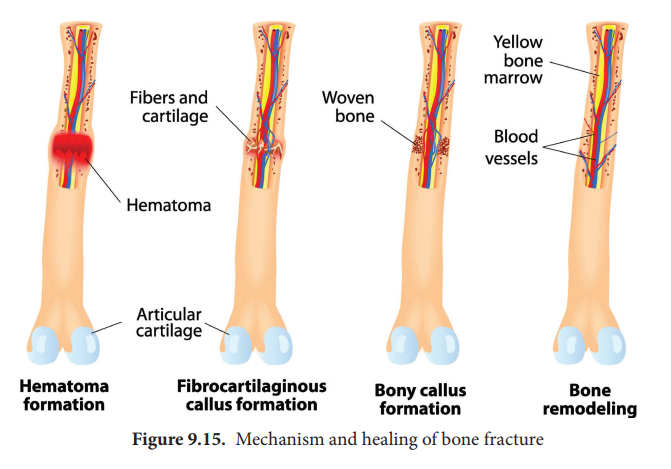Chapter: 11th Zoology : Chapter 9 : Locomotion and Movement
Mechanism and healing of a bone fracture

Mechanism and healing of a bone fracture
Bone is a cellular, living tissue capable of
growth, self-repair and remodeling in response to physical stresses. In the
adult skeleton, bone deposit and bone resorption occur. These two processes
together constitute in remodeling of bone. There are four major stages in
repairing a simple fracture (Figure 9.15).
1. Formation of haematoma
When a bone breaks the blood vessels in the bone and surrounding tissues are torn and results in haemorrhage. Due to this a haematoma, a mass of clotted blood forms at the fracture site. The tissues at the site becomes swollen, painful and inflammed. The death of bone cells, occur due to lack of nutrition.
2. Formation of fibrocartilaginous callus
Within a few days several events lead to the
formation of soft granulation tissue called callus. Capillaries grow into the
haematoma and phagocytic cells invade the area and begin to clean up the
debris. Meanwhile the fibroblasts and osteoblasts invade from the nearby
periosteum and endosteum and begin reconstructing of the bone. The fibroblasts
produce fibres. The chondroblasts secrete the cartilage matrix. Within this
repair tissue, osteoblasts begin forming spongy bone. The cartilage matrix later
calcifies and forms the fibrocartilaginous callus.
3. Formation of Bony callus
New bone trabeculae begin to appear in the fibro
cartilaginous callus. Gradually that is converted into a bony (hard) callus of
spongy bone. Bony callus formation continues until a firm union is formed about
two months later to an year for complete woven bone formation.
4. Remodeling of Bone
Bony callus formation will be continued for several
months. After that the bony callus is remodelled. The excess material on the
diaphysis exterior and within the medullary cavity is removed and the compact
bone is laid down to reconstruct the shaft walls. The final structure of the
remodelled area resembles like the unbroken bony region.

Related Topics